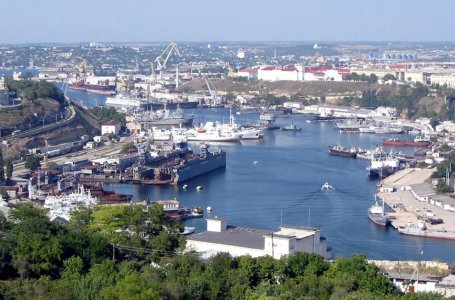Olga Efimova
Crimean port industry is suffering significant losses amid breaking economic relations with Ukraine and Western sanctions imposed on the port enterprises of the occupied peninsula. As a result, a cargo turnover is reduced and workers are fired. All this happens amid the pompous reports of the local “authorities” on economic growth and the development of the peninsula after the occupation.
Crimean ports in Ukraine
 There were five major seaports – in Kerch, Sevastopol, Yalta, Feodosia and Evpatoria – and two fishing seaports (in Sevastopol and Kerch) that functioned in Crimea before the annexation. At that time, the share of Crimean ports in the total seaborne cargo turnover of Ukraine amounted only to 6.5%. For example, the biggest cargo turnover was recorded in the Sevastopol port in 2013 – 4.8 million tons that was almost 10 times less than the figures of the port “Yuzhnuy” and 5 times less than the number of cargo transported through the Odessa port. In total, more than 11.3 million tons of cargo passed through the Crimean ports in 2013.
There were five major seaports – in Kerch, Sevastopol, Yalta, Feodosia and Evpatoria – and two fishing seaports (in Sevastopol and Kerch) that functioned in Crimea before the annexation. At that time, the share of Crimean ports in the total seaborne cargo turnover of Ukraine amounted only to 6.5%. For example, the biggest cargo turnover was recorded in the Sevastopol port in 2013 – 4.8 million tons that was almost 10 times less than the figures of the port “Yuzhnuy” and 5 times less than the number of cargo transported through the Odessa port. In total, more than 11.3 million tons of cargo passed through the Crimean ports in 2013.
However, despite the low level of cargo turnover, Crimean ports played an important role in the maritime transport system of Ukraine. Thus, about 4 million tons of grain (10% of total Ukrainian export) were exported and more than 1 million tons of oil products (about 10% of Ukrainian domestic market’s needs) were imported through these ports. A serious loss for the Ukrainian economy was fishing ports – in Sevastopol and Kerch, through which 70% of fish cargo traffic was carried out.
New status and international sanctions
 Crimean ports were quite profitable enterprises and therefore, they became a first and foremost subject of nationalization for the Crimean occupying authorities. The next day after the “referendum”, on March 17, the Crimean “parliament” transferred all the ports of the peninsula into the state ownership. On March 26, the State Unitary Enterprise (SUE) “Crimean seaports” that got 5 of 7 nationalized ports (except the Sevastopol ones) under own control was established. On June 2, 2014, the SUE “Sevastopol seaport” was established on the base of commercial and fishing ports.
Crimean ports were quite profitable enterprises and therefore, they became a first and foremost subject of nationalization for the Crimean occupying authorities. The next day after the “referendum”, on March 17, the Crimean “parliament” transferred all the ports of the peninsula into the state ownership. On March 26, the State Unitary Enterprise (SUE) “Crimean seaports” that got 5 of 7 nationalized ports (except the Sevastopol ones) under own control was established. On June 2, 2014, the SUE “Sevastopol seaport” was established on the base of commercial and fishing ports.
On March 27, 2014, the UN Assembly adopted a resolution that recognized Crimea as the territory of Ukraine. In fact, it meant that the International Mariime Organization should also recognize the territorial belonging of Crimea to Ukraine and as a result, it was done.
On April 29, 2014, the Cabinet of Ministers of Ukraine excluded all Crimean seaports from the list of Ukrainian seaports open to foreign vessels. On November 7, 2014, the European Bureau of the World Health Organization published a new list of ports authorized to issue vessel’s sanitary certificates, in which there were no Crimean ports. The WHO has not recognized their Russian jurisdiction and not included them in the list of Russian ports. These measures drastically reduced the number of vessels wishing to visit ports of the occupied peninsula.
“A vessel that entered the occupied Crimea may not to be accepted in the ports of civilized countries – they won’t have any legitimate sanitary certificate from the previous port,” the editor of the Black Sea News portal Andrei Klimenko commented on the situation.
The sanctions imposed by the European Union and the United States became another blow to the Crimean ports. On July 26, 2014, the EU imposed sanctions against a number of nationalized Crimean enterprises, including two Crimean ports – Sevastopol and Kerch commercial seaports. On July 30, 2015, Evpatoria, Feodosia, Kerch, Sevastopol and Yalta seaports were put under the US sanctions.
Crimean ports under occupation
 With the reduction and then complete cessation of railway communication with Ukraine, as well as while being influenced by the Western sanctions, the cargo turnover of the Crimean ports began to decline and by the end of 2014, it amounted to only 3 million tons compared to 11.3 million tons in 2013. The occupation authorities started to talk about the closure of Feodosia and Evpatoria ports because of unprofitability of their operation.
With the reduction and then complete cessation of railway communication with Ukraine, as well as while being influenced by the Western sanctions, the cargo turnover of the Crimean ports began to decline and by the end of 2014, it amounted to only 3 million tons compared to 11.3 million tons in 2013. The occupation authorities started to talk about the closure of Feodosia and Evpatoria ports because of unprofitability of their operation.
In 2015, the situation improved a little bit due to the growth of turnover deliveries from Russia and the resumption of relations with the Turkish business that didn’t stop trade relations with Crimea despite international sanctions. Since August 2015, a ferry service between Sevastopol and the Turkish port Zonguldak started to operate. Then, ferries from Turkey started to enter Feodosia, it was planned to establish the communication with Feodosia. According to Rospotrebnadzor (the Federal Service for Supervision of Consumer Rights Protection and Human Wellbeing), about 400 tons of fruits were imported in Crimea from Turkey through Sevastopol and Evpatoria ports just for twenty days in October of 2015.
However, the Russian military plane shot down in the Turkish skies buried all plans for cooperation – Crimea announced the rupture of relations with Turkey among the first. The ferry service was terminated and the staff again were left without work.
At the same time, the Russian statistics show very good operating results of the Crimean port system. For example, according to preliminary results of 2015, the cargo turnover of all peninsula’s ports amounted to 9.6 million tons and this is only a little less than in 2013. However, 80% of cargo traffic (7.8 million tons) is accounted for Kerch, through which the supply of goods from Russia is carried out. With such a workload of the port, 50 people were fired at the enterprise at the end of 2015, and it is planned to fire another 710 people in April. What can we say about the other ports of the peninsula, for which only 1.8 million tons of the cargo turnover is accounted?
One of ways to keep the Crimean ports afloat remains port fees, which turned out to be much higher than the average fees in Russia. For example, the maintenance cost for a vessel with a capacity of a little more than 7 million tons is estimated at 370 000 rubles in Kerch, while in the port of Temryuk – it is less than 200 thousand rubles. These tariffs turned out to be interesting for the Crimean department of the Federal Antimonopoly Service that initiated the inspection at the SUE “Crimean seaports”, the results of which will likely happen to be disappointing for the enterprise.
The Crimean port system is going through hard times today. While being focused on the foreign trade, Crimean ports were de jure closed to foreign vessels because of the peninsula’s unrecognized status. The rupture of economic relations with Turkey because of the military-political scandal deprived the Crimean port facilities of virtually the last possibility to carry out the international trade. Now the ports of the peninsula are open only for the import of Russian products as there is almost nothing to be exported from Crimea. The Kerch port can easily perform these tasks. The fate of other ports remains doubtful.












